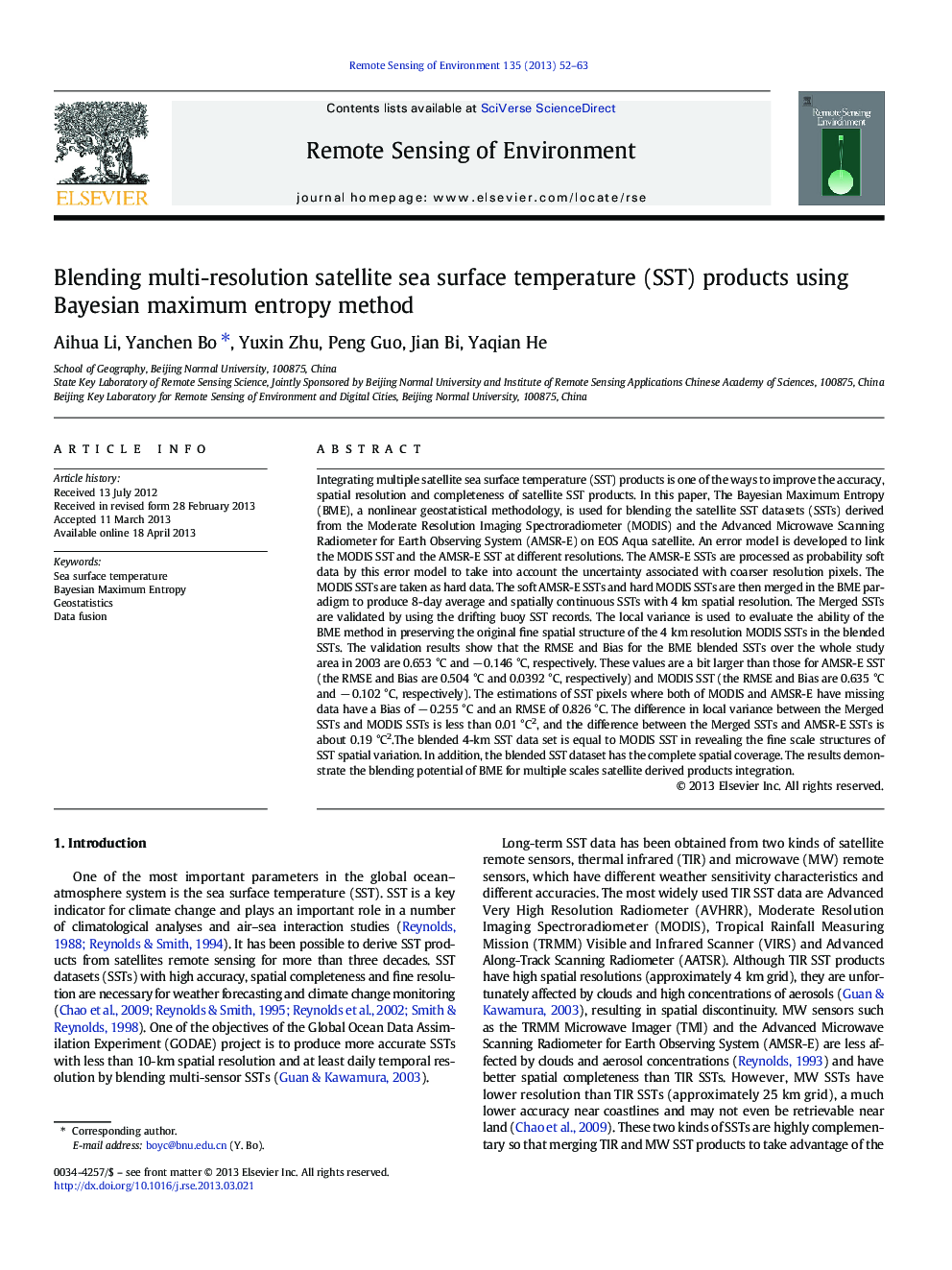| کد مقاله | کد نشریه | سال انتشار | مقاله انگلیسی | نسخه تمام متن |
|---|---|---|---|---|
| 6347292 | 1621265 | 2013 | 12 صفحه PDF | دانلود رایگان |
عنوان انگلیسی مقاله ISI
Blending multi-resolution satellite sea surface temperature (SST) products using Bayesian maximum entropy method
دانلود مقاله + سفارش ترجمه
دانلود مقاله ISI انگلیسی
رایگان برای ایرانیان
کلمات کلیدی
موضوعات مرتبط
مهندسی و علوم پایه
علوم زمین و سیارات
کامپیوتر در علوم زمین
پیش نمایش صفحه اول مقاله

چکیده انگلیسی
Integrating multiple satellite sea surface temperature (SST) products is one of the ways to improve the accuracy, spatial resolution and completeness of satellite SST products. In this paper, The Bayesian Maximum Entropy (BME), a nonlinear geostatistical methodology, is used for blending the satellite SST datasets (SSTs) derived from the Moderate Resolution Imaging Spectroradiometer (MODIS) and the Advanced Microwave Scanning Radiometer for Earth Observing System (AMSR-E) on EOS Aqua satellite. An error model is developed to link the MODIS SST and the AMSR-E SST at different resolutions. The AMSR-E SSTs are processed as probability soft data by this error model to take into account the uncertainty associated with coarser resolution pixels. The MODIS SSTs are taken as hard data. The soft AMSR-E SSTs and hard MODIS SSTs are then merged in the BME paradigm to produce 8-day average and spatially continuous SSTs with 4 km spatial resolution. The Merged SSTs are validated by using the drifting buoy SST records. The local variance is used to evaluate the ability of the BME method in preserving the original fine spatial structure of the 4 km resolution MODIS SSTs in the blended SSTs. The validation results show that the RMSE and Bias for the BME blended SSTs over the whole study area in 2003 are 0.653 °C and â 0.146 °C, respectively. These values are a bit larger than those for AMSR-E SST (the RMSE and Bias are 0.504 °C and 0.0392 °C, respectively) and MODIS SST (the RMSE and Bias are 0.635 °C and â 0.102 °C, respectively). The estimations of SST pixels where both of MODIS and AMSR-E have missing data have a Bias of â 0.255 °C and an RMSE of 0.826 °C. The difference in local variance between the Merged SSTs and MODIS SSTs is less than 0.01 °C2, and the difference between the Merged SSTs and AMSR-E SSTs is about 0.19 °C2.The blended 4-km SST data set is equal to MODIS SST in revealing the fine scale structures of SST spatial variation. In addition, the blended SST dataset has the complete spatial coverage. The results demonstrate the blending potential of BME for multiple scales satellite derived products integration.
ناشر
Database: Elsevier - ScienceDirect (ساینس دایرکت)
Journal: Remote Sensing of Environment - Volume 135, August 2013, Pages 52-63
Journal: Remote Sensing of Environment - Volume 135, August 2013, Pages 52-63
نویسندگان
Aihua Li, Yanchen Bo, Yuxin Zhu, Peng Guo, Jian Bi, Yaqian He,